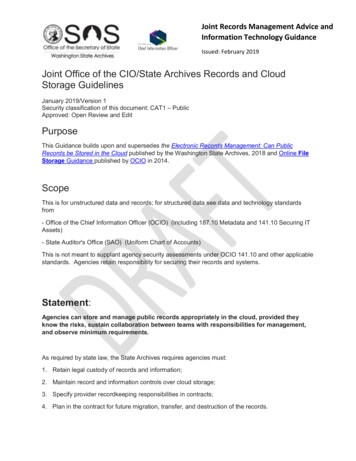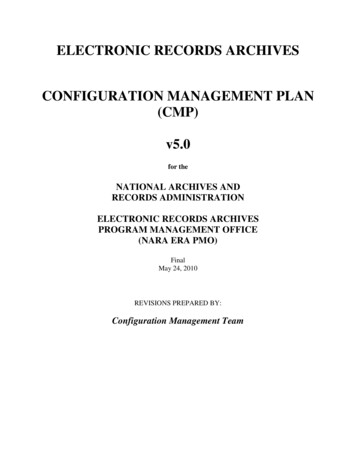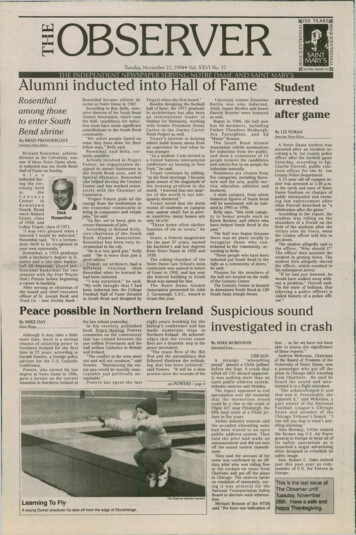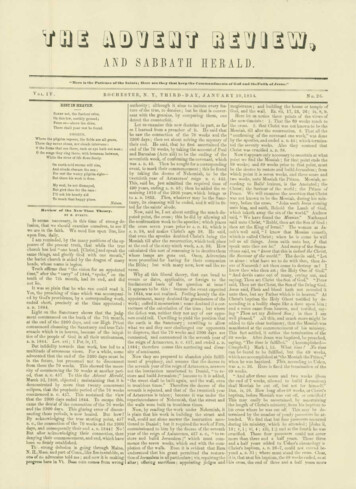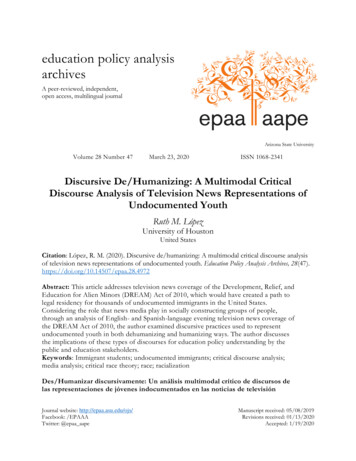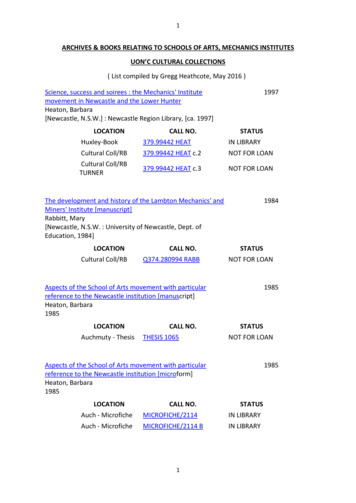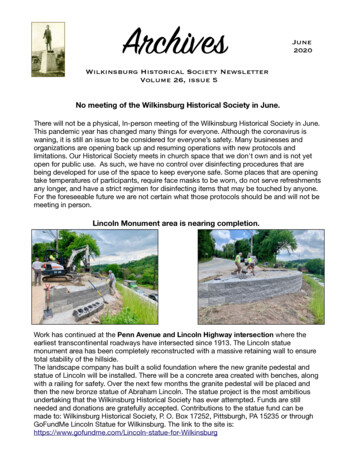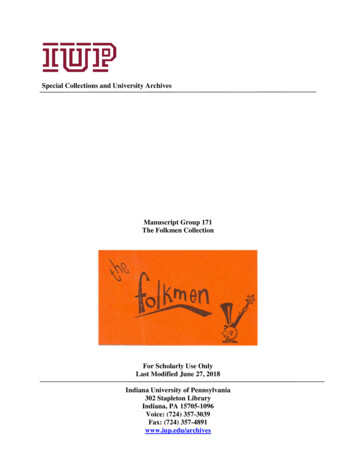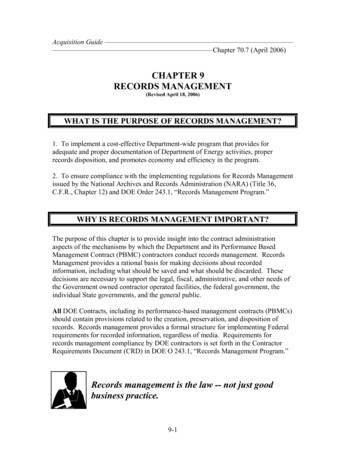
Transcription
Acquisition Guide Chapter 70.7 (April 2006)CHAPTER 9RECORDS MANAGEMENT(Revised April 18, 2006)WHAT IS THE PURPOSE OF RECORDS MANAGEMENT?1. To implement a cost-effective Department-wide program that provides foradequate and proper documentation of Department of Energy activities, properrecords disposition, and promotes economy and efficiency in the program.2. To ensure compliance with the implementing regulations for Records Managementissued by the National Archives and Records Administration (NARA) (Title 36,C.F.R., Chapter 12) and DOE Order 243.1, “Records Management Program.”WHY IS RECORDS MANAGEMENT IMPORTANT?The purpose of this chapter is to provide insight into the contract administrationaspects of the mechanisms by which the Department and its Performance BasedManagement Contract (PBMC) contractors conduct records management. RecordsManagement provides a rational basis for making decisions about recordedinformation, including what should be saved and what should be discarded. Thesedecisions are necessary to support the legal, fiscal, administrative, and other needs ofthe Government owned contractor operated facilities, the federal government, theindividual State governments, and the general public.All DOE Contracts, including its performance-based management contracts (PBMCs)should contain provisions related to the creation, preservation, and disposition ofrecords. Records management provides a formal structure for implementing Federalrequirements for recorded information, regardless of media. Requirements forrecords management compliance by DOE contractors is set forth in the ContractorRequirements Document (CRD) in DOE O 243.1, “Records Management Program.”Records management is the law -- not just goodbusiness practice.9-1
Acquisition Guide Chapter 70.7 (April 2006)WHAT IS THE VALUE OF A SOUND RECORDSMANAGEMENT PROGRAM?The availability of complete and accurate documentation under the RecordsManagement Program allows the Department to: Protect the legal and financial rights of the Government and of individualsdirectly affected by Government activities; and Preserve institutional memory so that informed decisions are possible and thusfacilitate action by DOE and PBMC contractor officials and their successors.THE FUNDAMENTALS:DEFINITIONS AND FRAMEWORKWhat is the definition of “records?”The statutory definition of “records” (44 United States Code 3301) is:“books, papers, maps, photographs, machine readable materials, or otherdocumentary materials, regardless of physical form or characteristics, made orreceived by an agency of the United States Government under Federal law or inconnection with the transaction of public business and preserved or appropriatefor preservation by that agency or its legitimate successor as evidence of theorganization, functions, policies, decisions, procedures, operations or otheractivities of the Government or because of the informational value of the data inthem.”To what records does this definition apply?This definition applies to all Departmental records including those created, received,and maintained by all contractors pursuant to their contracts. It is important toremember that depending on the content, e-mails are potential records and whereapplicable must be considered as such in accordance with DOE O 243.1, “RecordsManagement Program.” The same holds true for documents posted on websites andportals. Additional policy and guidance addressing e-mail and web/portal recordswill be forthcoming in the Records Management Manual and the RecordsManagement Handbook. Virtually all recorded information in the custody of theGovernment (including information created by contractors on behalf of the9-2
Acquisition Guide Chapter 70.7 (April 2006)Government) regardless of its media (hard copy, machine-readable, microfilm, orelectronic) is considered to be “Government” records. Records may include, not onlythe deliverables specified by the contract, but can also include any supporting orbackup data used to create the deliverables, and related health, safety andenvironmental information.Does the Department retain ownership of all records produced in associationwith its contracts?No! The Department recognizes the right of its contractors to retain ownership ofcertain records. DEAR 970.5204-3, “Access to and Ownership of Records.,” setsforth certain categories of records which may be considered to be the property of thecontractor: It is the responsibility of the contracting officer to identify which of thefollowing categories of records will be included in the clause as contractor ownedrecords: Employment-related records except for those records described by thecontract as being maintained in Privacy Act systems of records; Confidential contractor financial information, and correspondence betweenthe contractor and other segments of the contractor located away from theDOE facility; Records relating to any procurement action by the contractor, except forrecords that under 48 CFR (DEAR) 970.5232-3, “Accounts, Records, andInspections;” Accounts, Records, and Inspection, are described as the property of theGovernment; Legal records, including legal opinions, litigation files, and documentscovered by the attorney-client and attorney work product privileges; and Certain records maintained pursuant to the technology transfer clause of thiscontract.What is Records Management?Records Management refers to the planning, budgeting, organizing, directing,training, and control involved in managing the life cycle of records in any medium.9-3
Acquisition Guide Chapter 70.7 (April 2006)This life cycle encompasses the interrelated and interdependent phases of recordscreation or collection, records maintenance and use, and records disposition:a.Phase I, Creating Records, includes the early capture of records in order toprovide adequate and proper documentation of government activities. This isachieved by complying with record keeping requirements established byDepartment policy and at each site.b.Phase II, Using and Maintaining Records, includes document control; files andfiling equipment management; identification and maintenance of vital records(disaster recovery and rights and interests records), quality assurance records,and records requiring protection for national security reasons. In accordancewith the Interim Records Management Program Policy issued March 30, 2004,electronic records, such as e-mail and word processing documents, must bemaintained in an approved Electronic Records Management System meeting therequirements of DOE-STD-4001-2000, or be printed and retained as paper files.Temporary electronic systems, such as Instant Messaging, cannot be used forconducting official departmental business.c.Phase III, Records Disposition, includes appraising (placing value on) andscheduling records, retiring, storing and retrieving records, and preservinghistorical records. Records that have reached the end of life may be destroyed ortransferred at the time specified in the Records Schedules.Why is Records Management critical to administering the Department’s PBMCcontracts?A criticality in dealing with records management under the Department’s sitemanagement PBMCs arises from the hazardous nature of much of the work beingconducted at the sites. The potential risks in doing this work result in concerns forthe health and welfare of individual workers, the natural environment, the interest ofthe general public and liabilities to the Department. It is imperative that theDepartment maintain records in a way which cost effectively addresses all of theseconcerns.Because of the potential risks, the potential significant liabilities, and the importanceof maintaining records on the work performed, the integration and close coordinationof the various members of the contract administration team is paramount.9-4
Acquisition Guide Chapter 70.7 (April 2006)What determines who will be involved in the administration of records under thecontract?The types of records and which offices have cognizance over those records willinfluence what offices will be members of the Records Management part of thecontract administration team. The Contracting Officer (CO), the site Records Officer,the Project Manager, attorneys, and others are possible members of the contractadministration team in this area.Moratoria on the Destruction of Records:The routine disposition of records created and maintained by the DOE and itsContractors may be suspended by a Program Manager or Site Manager through theissuance of a Moratorium. A Moratorium may be required to: Suspend the routine disposition of Departmental and Contractor records tosupport an investigation, Preserve records for research, Identify lessons learned in recovery operations from natural disasters or otheremergencies Provide evidence for a legal action.Remember that moratoria on records destruction are ineffect for certain types of records.Contractors should determine if a moratorium exists prior to the disposition ofrecords. The DOE has an obligation to inform the Contractors when a moratorium isplaced or removed from Federal records. Notification of a Moratorium will be madeformally through the issuance of a letter. These letters are posted on the DOE/HQRecords Management Web site at Appendix B of this Reference Book.9-5
Acquisition Guide Chapter 70.7 (April 2006)What are Disposition Schedules?Records Disposition Schedules document the value of government records.Schedules include listings of record categories or “series” and length of time eachshould be retained. For disposition purposes, records are divided into two types: “Permanent” records are those records with special significance and enduringvalue. They are retained by the Department for as long as needed and legalcustody is then transferred to the National Archives. “Temporary” records have limited value and are retained only for adesignated period of time prior to disposition. Disposition may includedestruction or storage at a Federal Records Center or a local records storagefacility.Records Disposition Schedules, although coordinated through DOE HQ, must beapproved by the Archivist of the United States.DOE Administrative Records Schedules have been created for the Department and,when justified by the uniqueness of the records, site-specific Schedules are created.Programmatic Records Schedules have been created for specific DOE Programs.Records Disposition Schedules are applicable to all Federal records whether createdby the Department or its Contractors.No matter which organization created the record, they must be maintained for thelength of time identified in the DOE Records Dispositions Schedules posted on theDOE Records Management Web Pages. Approved DOE Disposition Schedules andthe Federal Government’s General Records Schedules are accessible at the DOERecords Management web page at Appendix B.THE PAPERWORK REDUCTION ACTWhat is the Paperwork Reduction Act?One of the statutes which influence Records Management is the Paperwork ReductionAct of 1994, as amended (44 USC Sections 3501-3520).The purpose of the Act is to: Minimize the Federal paperwork burden of individuals, small businesses,State and local governments, and other persons;9-6
Acquisition Guide Chapter 70.7 (April 2006) Minimize the cost to the Federal Government of collecting, maintaining,using, and disseminating information; Maximize the usefulness of information collected, maintained, anddisseminated by the Federal Government; Coordinate, integrate and, to the extent practicable and appropriate, makeuniform Federal information policies and practices; Ensure that automatic data processing, telecommunications, and otherinformation technologies are acquired and used by the Federal Government ina manner which improves service delivery and program management,increases productivity, improves the quality of decision making, reduceswaste and fraud, and wherever practicable and appropriate, reduces theinformation processing burden for the Federal Government and for personswho provide information to and for the Federal Government; and Ensure that the collection, maintenance, use and dissemination of informationby the Federal Government is consistent with applicable laws relating toconfidentiality, including the Privacy Act.The Paperwork Reduction Act is implemented in the Department’s contracts byDEAR 952.224-70, “Paperwork Reduction Act.” The clause is used if it isanticipated that information collection from 10 or more persons will be necessaryunder the contract.The clause requires that in the event that it subsequently becomes a requirement tocollect or record information calling either for answer to identical questions from 10or more persons other than Federal employees, or information from Federalemployees which is to be used for statistical compilations of general public interest,the Paperwork Reduction Act will apply to the contract.Under the clause no plan, questionnaire, interview guide, or other similar device forcollecting information may be used without first obtaining clearance from the Officeof Management and Budget.9-7
Acquisition Guide Chapter 70.7 (April 2006)THE PRIVACY ACTWhat is the Privacy Act?The Privacy Act of 1974, as amended, 5 U.S.C. 552a, balances the government’sneed to maintain information about individuals with the right of individuals to beprotected from unwarranted invasion of their privacy that may arise from a federalagencies’ collection, maintenance, use and disclosure of personal information aboutthem.The purpose of the Act is to
electronic records, such as e-mail and word processing documents, must be maintained in an approved Electronic Records Management System meeting the requirements of DOE-STD-4001-2000, or be printed and retained as paper files. Temporary electronic systems, such as Instant Messaging, cannot be used for conducting official departmental business. c. Phase III, Records Disposition, includes .


